#mesarch
Text
Sentando gostoso minha mulher safada
Marito y Susana quiere en cuatro y que le haga doble penetracion x el culo
Sexy ass teen thief fucked by dirty cop
Free movies on twinks fucking and pakistani gay porn xxx Jacob
Nathalia Villeth Putinha
Riquisima mamada de verga
Tread mill ass at planet fitness white bitch wears grey or gray
Massage porn starring super hot Thai girl
Office lady in Bangkok Horizon condo
Getting face fucked by daddy
#Housum#waferwork#nonerrantly#raciest#Ampelosicyos#Swarthmore#lemon-faced#noodling#hardsalt#dea-nettle#tetrobolon#spaders#calcaneal#cackler#Coalwood#isotonicity#nomarchs#coindicate#Bakshaish#mesarch
0 notes
Text









Repurposing Manhattan’s Boutique Store to a Modern Office
In the historical Noho neighbourhood of Manhattan, Mesarch Studio Architecture + Interior Design repurposes an old boutique store into a light and airy office space across 13 floors. https://www.indiaartndesign.com/repurposing-manhattans-boutique-store-to-a-modern-office/
#commercialarchitecture#commercialinteriordesign#officedesign#adaptivereuse#repurposingbuildings#indiaartndesign
0 notes
Text
#architecture#amazingarchitecture#design#interiordesign#architect#archilovers#luxury#photooftheday#travel#architecturephotography
0 notes
Photo

Mesarch Newspaper Article
“Αρχιτεκτονική Ιστορία του Παρλθόντος και του Μέλλοντος στην Κύπρο” [Architectural History of the Past and Future in Cyprus], Article in Phileleftheros (10 July, 2022).
0 notes
Text
FOMA 25: Unseeing in the Cypriot Contested Cities
This FOMA is dedicated to the modernist architecture in Cyprus. Socrates Stratis is in search of the unseeing architecture and the cities following the novel The City and the City by China Mieville.
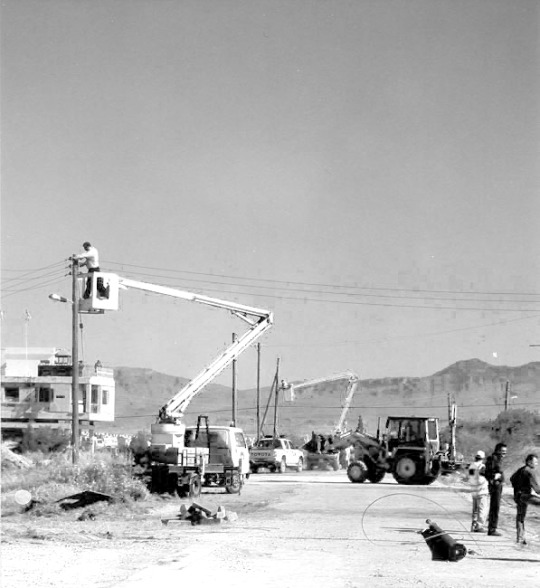
Opening a passage through the UN-Buffer Zone at Agios Dometios, Nicosia in 2004. | Photo by Socrates Stratis
Unseeing in the city and the city
In his novel Mieiville describes the unseeing as the ability of taking out of one’s sight and suppress from one’s memory any presence of the other city, its inhabitants, buildings and activities. Any attempt to see the other, even accidentally, is considered a crime like commit a murder. A secret power, the Breach, vanishes any trespassers. The story begins with inspector Borlu from the police department of the city of Besźel, having given permission to investigate the crime of a killed young lady in the city of Ul Qoma. The reader is kept in the dark, regarding the proximity of Besźel and Ul-Qoma but well informed about the precise and controlled ways of crossing over to the other side.

Besźel and Ul Qoma occupy the same space with the same streets but different names. | Photo via Simon Rowe
This FOMA will present the practices of unseeing Cypriot modernist architecture as manifestation of the Cypriot conflict. Cypriots, both Greek and Turkish speaking, learn already from childhood how to unsee the other, entering into a conflictual process of perpetual forgetting, negation and suppressing the presence of others. In Cypriot cities, like in Besźel and Ul Qoma, exist different names of the same places. The actual condition of six modernist buildings in Cyprus will help to understand how conflict is related to practices of unseeing at three different levels; territoriality, property with its representation and inaccessibility.
Cypriot Modernist Architecture Caught in a Perpetual Conflict
Architecture is quite often a vehicle of consolidating States’ agendas into space. Building the Republic of Cyprus in the 1960s, went hand-in-hand with the establishment of the modernist architecture. Infrastructures, public buildings, tourist developments and single housing were part of the State’s foundation. Rather often, the processes of designing such projects were caught in the Cypriot post-colonial conflict. There is on-going work in Cyprus regarding the role of architecture and conflict [Stratis], including role modernist architecture and its relation to the Eastern Mediterranean post-colonial politics [MesArch LAb].
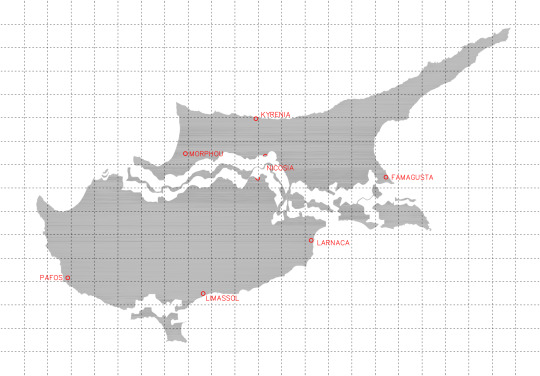
Cyprus in fragments. | Source AA&U
The Cyprus’ conflict milestones are the inter-communal fights in 1963. The military putsch instigated by the Greek Junta and its local supporters followed by the Turkish invasion in the summer of 1974. The north part of the island is currently under the control of Turkey, shadowing over the Turkish Republic of Northern Cyprus that is a non-recognized internationally except by Turkey. Because of the 1974 Turkish invasion, the north part of the island was emptied by its 162,000 Greek Cypriots inhabitants who were forced to move to the south. The population in the south part of the island is 856.960 according to the 2011 population census of the Republic of Cyprus. In 1974 about 48,000 Turkish Cypriots were displaced from the south to the north to join the 70,000 Turkish Cypriots in the north. They had to cohabit with a much bigger number of Turkish settlers moved to the island from Turkey [Gürel, 2009]. The Turkish migration created second class citizens and a colonization tool for Turkey by outnumbering the Turkish Cypriots. The population of the north part of Cyprus reaches 300,000 according to 2011 UN demographics. Any population data regarding the incoming Turkish population is contested between the two communities, being one of the main obstacles to any political agreement.
Unseeing Buildings and Cities
For Greek Cypriots Famagusta is Ammochostos, Kyrenia - Kerynia, Morphou - Morphou, Nicosia – Lefkosia. For Turkish Cypriots the names change, Famagusta is Magusa, Kyrenia - Girne, Morphou - Guzelyurt, Nicosia - Lefkosa. Larnaka seems to hold the same name for both Turkish and Greek Cypriots. Some of the Turkish names were official before the 1974 war, while others, mainly on the north part, were created after the war. According to the social anthropologist Yael Navaro Yashin (2012) such a practice is based on a policy for erasing Greek Cypriots’ ownership and traces of use, establishing therefore, the legitimacy of a make-believe space for the Turkish Cypriots.
The six modernist buildings that embody the island’s conflict, were built between late 1950s and early 1970s. They are located in Famagusta, Kyrenia, Morphou, Larnaca and Nicosia. The municipal halls built by the Greek Cypriots after the 1963 conflict are located in Famagusta, Kyrenia and Morphou. The Municipal market in Larnaka is located in the city centre at the edge of the former Turkish Cypriot Zouhouri quarter. The two residential buildings are trapped in Turkish military zones and they are close to the check points of Nicosia and Famagusta, where people cross the demilitarized zone between the south and north controlled by the United Nations.
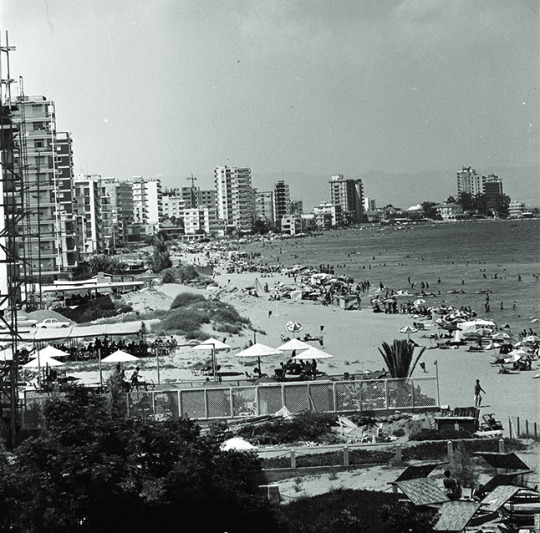
Pre-1974 waterfront tourist development of Famagusta. | Photo via Press and Information Office, Government of the Republic of Cyprus – PIO
Imaginary and Physical Territorialities: The Municipal Halls
The three municipal halls of Famagusta, Kyrenia and Morphou were hosting the Republic of Cyprus’ municipalities until the war of 1974. After the 1963 bi-communal conflicts, they were serving mostly the Greek Cypriot population. Since 1974, they host the municipal functions of the Turkish Cypriots. The unseeing of three municipal halls has a double interconnected connotation. The first is the removal of the public buildings’ initial symbolic value associated with the Greek Cypriots and the addition of a new symbolic value linked to the Turkish Cypriot claim of governing the occupied territories. The second is the creation of exiled municipalities by the Greek Cypriots in the south part of the island. The Famagusta municipality is hosted in Limassol, the Kyrenia and Morphou ones are located in Nicosia.
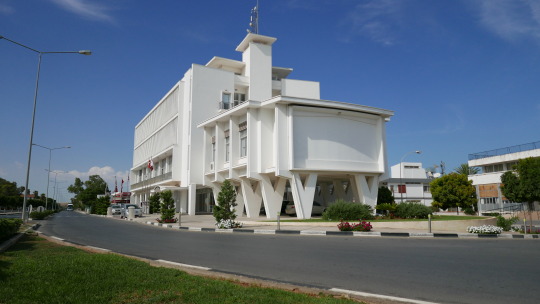
The Famagusta Municipal Hall (1966). | Photo by Socrates Stratis
Despite the displacement from their cities, the Greek Cypriots have kept their municipal authorities as a mode of resistance to Turkish occupation, seeking return to their homelands. They elect their mayors and have their municipal counselors organizing all sorts of events for the displaced inhabitants. They reject the actual control of their municipalities and cities by the Turkish Cypriots and Turks, keeping a distorted memory of their pre-1974 hometowns. They have developed their imaginary territorialities.
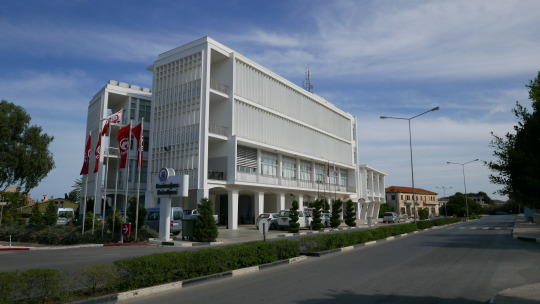
The Municipal Hall is organized in a V shape floor plan, following the geometry of the two convergent streets. | Photo by Socrates Stratis
The Famagusta Municipal Hall is located along the main street with the administration buildings constructed during the British mandate. The street connects the walled city of Famagusta, that used to be populated mainly by Turkish Cypriots. The Varosha area, that used to be populated mainly by Greek Cypriots, is actually inaccessible due to its control by the Turkish army. The municipal building sits in an area that is supposed to be handed over to the administration of the South Region, to be created under the Federal State of Cyprus, where the Greek Cypriots will be a majority. Unfortunately, this new political model is falling short since the negotiations between the two communities have stopped in 2017.

The west facade of the two top floors of the Municipal Hall are covered with slim concrete louvers. | Photo via Architectoniki, Vol 55, 1966, p. 82
Only a few critical urban projects, commonly produced by the two communities, address the city’s future when the island will be reunified. The Hands-on Famagusta project has made explicit the need to include in the negotiations for the new Federal Cyprus, the role of governance of Famagusta as an undivided territory, abandoning the ethnically binary way of administration [Stratis, Akbil]. The on-going discussion seems to adopt the creation of separate Turkish and Greek Cypriot administrative territories under competing municipalities [Stratis]. The future of the municipal hall remains ambivalent.
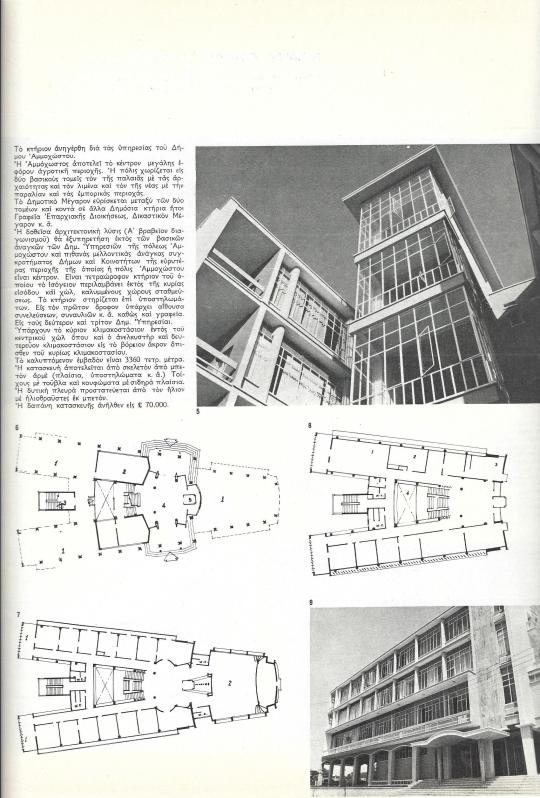
Famagusta Municipal Hall has a lower volume at the front and two linear ones on both sides. | Photo via Architectoniki, Vol 55, 1966, p. 83
The Municipal Hall in Kyrenia constructed in 1969 is a product of donations. It was donated by the Greek Cypriot Zena Kanther. It is located in the public garden of the city, a donation by Scottish inhabitant George Ludwig Huston. The main entrance opens into a public space overlooking the old city and the sea. Its back side opens into a garden. The two-floor building is organized into two superimposed and shifted square-plan volumes, creating different conditions along its perimeter.

Kyrenia Municipal Hallis a free standing object with all its sides exposed to the square.| Photo by Socrates Stratis
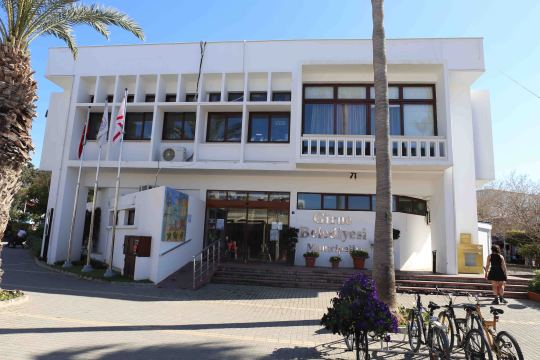
Since 1974 Kyrenia Municipal Hall has been painted in white, covering its original sand-like finishes.| Photo by Socrates Stratis
When talked to the Greek Cypriot exiled mayor in her office in Nicosia, she remarked that she had not gone back to her hometown since 1974. The Greek Cypriots refuse to see the 44 year old appropriation of the building by the Turkish Cypriot community, considering it illegal, where the Turkish Cypriot tenants unsee any use of the building before the 1974 war. Kyrenia will be part of the North Region with Turkish Cypriot majority in case of a political agreement based on the Cyprus Federal model. It remains rather vague whether the local authority structure of such Federal model will be based on the European acquis of local governance, allowing for co-habitation of citizens coming from various ethnic groups.

The modernist two-floor tall apartment building of the Morphou Municipal Hall. | Photo by Socrates Stratis
The Morphou Municipality Hall is located in the old city centre. The Guzelyurt’s inhabitants, mostly Turkish settlers and also Turkish Cypriots displaced from Polis Chrysochous, have been using the rented apartment building as municipal hall for the last 44 years. Before 1974 was also used by the Greek Cypriots.

Morphou Municipal Hall was built during the construction boom in the 1960s. | Photo by Socrates Stratis

The actual municipal building has shop-like ground floor and a first floor with offices around a courtyard. | Photo by Socrates Stratis
Morphou Municipal Hall is situated between three roads following the geometry of the convergent streets. Surprising fact is that the municipality was operating in a building for 44 years without any issued floor plans. During our first visit, I had the feeling that the occupants were in a sort of a temporal appropriation of a building that they found ready for use in 1974. The exiled municipality of Morphou is located in another apartment building in Nicosia. The Morphou area is supposed to be part of the South Region according to the failed United Nations plan of 2004. However, the on-going investments in construction and infrastructures by the Turkish Cypriots and Turkey are means to cancel out such potential.
Making a Market Invisible
The fourth building of the group under discussion is a small Turkish Cypriot Market in Larnaka built in 1955 and located in the city commercial center, just next to the major city market.


The complex was used as the Turkish Cypriot market up to 1963. | Photo by Chrysanthe Constantinou and AA&U
The owner of the building is Evkaf, the institutional body managing the Muslim religious land in Cyprus. The building permit files show that the construction was meant to be for commercial shops. It is not clear how it was used from1955 up to the 1963 bi-communal conflict, when the Turkish Cypriots were forced to move further west, trapped in an ethnic ghetto. This small ignored market doesn’t exist in the official cadastral plans, where we find instead, the site plan with the former traditional buildings, that were demolished probably in the 1950s to build the unseen market.
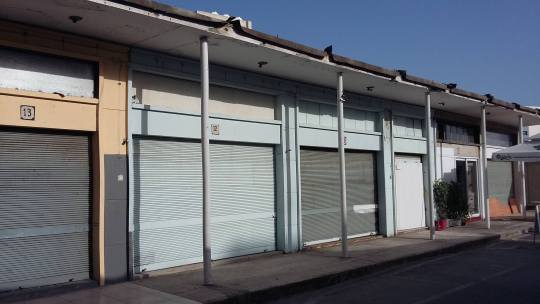
The market has an interesting scale, consisting of a series of shops completing the historic urban block of Zouhouri (courtyard view). | Photo by Vasilis Pasiourtides
The urban block also contains one floor stone-built workshops, a two-floor tall hostel and the Zouhouri mosque. They all surround a run-down courtyard, used for parking. The Market building completes the north edge of the urban block, creating an entry to a covered space leading to the courtyard. The market is occupied by Greek Cypriot tenants, some displaced from the north part of the island in 1974, some from the demolished market next door.

The roof, supported by very thin metal columns, creates a narrow covered space along the streets. | Drawing by AA&U
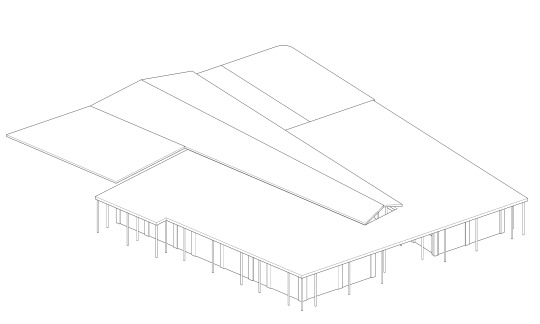
The roof that covers the courtyard space, is a later addition.| Drawing by AA&U

Larnaka municipality launched a competition in 2018 for the redevelopment of Zouhouri courtyard including the market. | Drawing by Municipality of Larnaka
I have participated in the competition with the AA&U agency, using our proposal as a critical political comment regarding the on-going conflictual use of Greek and Turkish Cypriot ownerships by the opposing communities. Both communities fail to bring into public debate both the controversial actual use of such properties as well as their potential in supporting the scenario of the island’s reunification. Since 1974 the agency of the Ministry of Internal Affairs of the Republic of Cyprus has managed all Turkish Cypriot properties in the south part of the island. The State agency rents out the Turkish Cypriot assets to the Greek Cypriots. The non-transparency of the procedures has led to many scandals of financial misuse. In the north part of the island, the Greek Cypriot properties, considerably more than those left behind by the Turkish Cypriots in the south, were given out to the Turkish Cypriots and Turkish settlers. The Turkish Cypriot authorities have created a parallel cadastre, non-recognized either by the Republic of Cyprus nor by international courts.
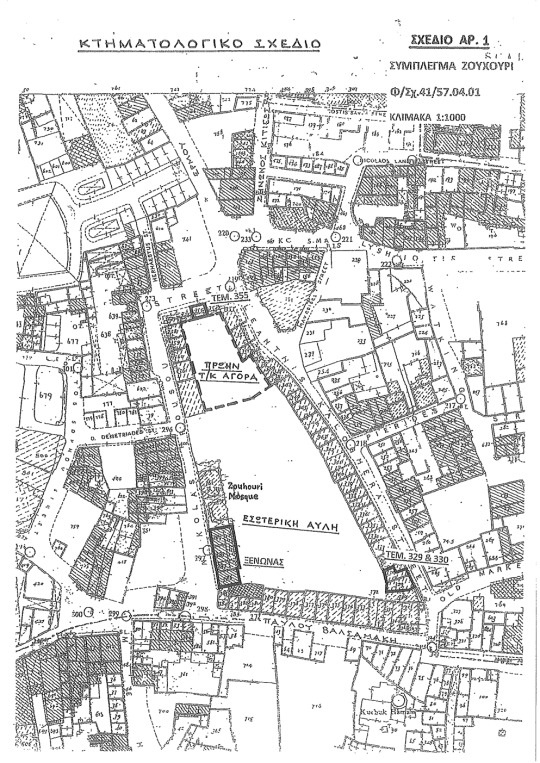
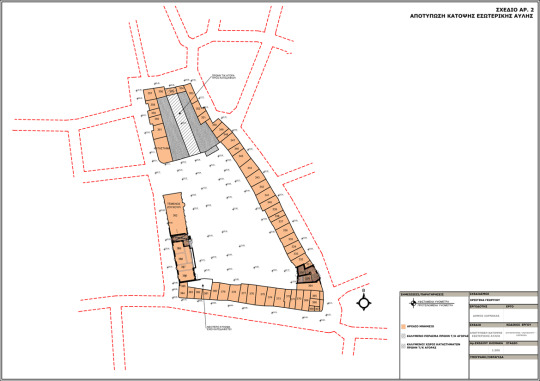
Turkish Cypriot Market. | Drawing by Municipality of Larnaka
In the case of the Zouhouri architectural competition, the monumentality of unseeing was manifested in the competition brief. The survey site plan included detailed plans and sections of the courtyard and of two 19th century-old stone buildings of the block to be restored. The brief also included a detailed drawing of the rundown facade of the back side of the market facing the courtyard. But the plan of the market was missing from the recently surveyed site plan of the Zouhouri urban block. Instead, there was a plan of the buildings demolished in the 1950s. The same buildings’ plan appears in the official cadastral map instead of the 1950s market building. When the competitors had asked for updated drawings of the market, they received an answer by the competition committee, that reminds us of the Breach Authority from the City and the City novel. It urged the competitors to unsee the market and proceed with the given drawings. Retaining invisible the actual plan, the Larnaka Municipality could keep invisible not only the Turkish Cypriot pre -1974 tenants but also the actual ones, getting most probably the liberty to proceed to any eviction agendas.
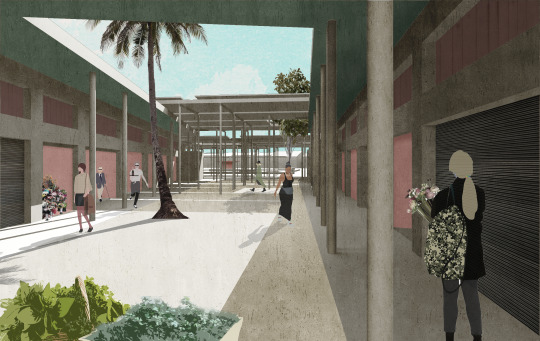
Refusing to unsee the market: The critical proposal for the Zouchouri architectural competition by AA&U: Urban Oasis - Zouchouri architectural competition entry by AA&U.
Not surprisingly, the shiny photorealistic renders of most of the competition entries, including that of the first prize, consolidated the competition committee’s decision to unsee the market. In its place, we see images of the pre 1950 demolished buildings.

The AA&U’s competition entry countered the competition committee’s instructions. We proceeded a meticulous survey of the market and based the proposal on the existing building, offering the plan survey to the city.
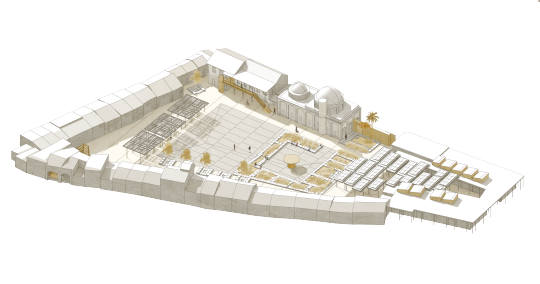
The breaching act of the AA&U entry was ignored by the competition committee. It chose to unsee any controversial issues of ownership and its representation. Surprisingly, the AA&U’s entry was awarded with an honorable mention for the overall proposal of the urban block.
Unliving Along the Checkpoints
The two residencies in Nicosia and Famagusta are 1960s suburb modernist architectures, following Le Corbusier’s five points of Architecture. They are both Greek Cypriot houses inaccessible to their owners since 1974, trapped in the Turkish military fenced-off areas and stripped from their content. They are both located along roads, which are part of check points between the north and south parts of the island crossing the UN demilitarized zone. The check point in Nicosia, Agios Dometios, opened in 2004, while that in Famagusta opened in 2018.
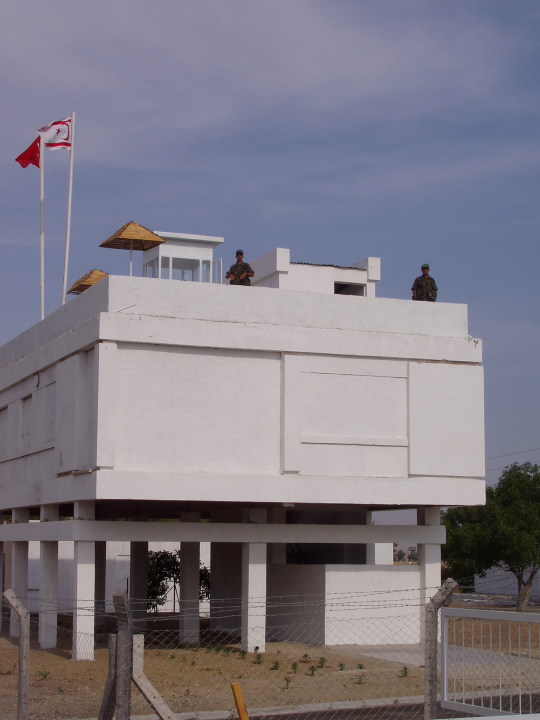
The modernist building in Nicosia is transformed into an army post, with doors and windows sealed and walls painted white. | Photo by Socrates Stratis
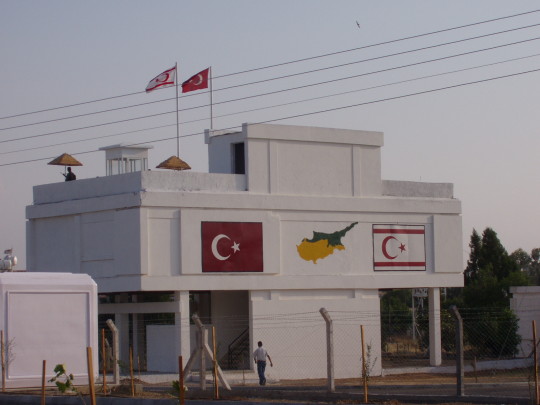
The flags of Turkey and “TRNC” at the north facade of the Agios Dometios with the plan of the divided island placed between them. | Photo by Socrates Stratis
In the case of Nicosia, the Turkish army turned the residential building into a new observation post, profiting from its adjacency to the Agios Dometios checkpoint. The modernist roof terrace is turned into an observation deck. By making visible their authority over the territory to the passing-by car drivers, they brought to the foreground the unseen modernist building.
The Famagusta Derynia checkpoint connects Derynia with the southern suburb of Famagusta, part of which is Varosha, the ghost part of the city. Since the opening of the check points in 2003, the Greek Cypriots visit Famagusta to see their homes. The same stands for the Turkish Cypriots, who cross to the south part of the island. The Greek Cypriots, whose homes are located outside the ghost part of the city have the chance to access them and find other people leaving inside for the last 44 years. There are 5,103 buildings hidden behind the modernist waterfront high-rise buildings. [Stratis].

The check point road towards the Famagusta city centre passes along the back side of the fenced-off area of Varosha, revealing another urban reality from that of the coastal high-rise buildings that Greek Cypriots have associated with the image of Famagusta. | Photo by Socrates Stratis

Facing sprawled empty suburban detached houses behind the fence. | Photo by Socrates Stratis
Very close to the checkpoint we run into a modernist house rather faithful to the Villa Savoye architectural paradigm. The practice of unseeing entails a new proximity of the trapped modernist buildings with the act of crossing to the other side. Their adjacency to the checkpoint roads, like the case of the Cupola between Besźel and Ul Qoma, condemns them to be looked at thousands of times and to be forgotten quite as many.
Unseeing Modernist Architecture Sustains the Cypriot Status-quo
”… inspector Borlu from the police department of the city of Besźel runs into an inconvenient truth. The assassinated girl was part of an American excavation expedition that had discovered a third city, Orciny. Orciny exists mysteriously in the interstices of Beszel and Ul Qoma, unseen by all inhabitants of the two cities. The mysterious Orcinians seem to use all means to keep their secret, like that of unseeing. It sustains the status quo of the two cities” writes Mieiville.
Unseeing practices in Cyprus, examined through the presented examples show that they pertain conflictual imaginaries between Cypriots. The modernist architecture in Cyprus has gone hand-in-hand with consolidating the State’s agendas in the 1960s, but also the agendas of the British Colonial Regime up to 1960. Unseeing practices become part of such consolidating agendas and invest in the continuation of the status quo on the island. Through the Municipal Halls, we have realized how the embodiment of physical and imaginary territorialites takes place, creating conflictual conditions instead of potentials of co-governing. In the case of the Municipal Market in Larnaka we have understood how a building can disappear from maps and institutions, a victim of an unresolved ownership conflict. When we look thousand times at the two residential buildings along the checkpoints, and we forget them as many times, we realize the powerful normalization processes of status quo in conflict areas. The agents keeping strong such processes remind us of the Orcinians who control the status quo of Beszel and Ul Qoma.
I couldn’t say who could be the Orcinians on the island. I am convinced that they much profit from the deeply conflictual imaginaries of the Cypriots’ urban everydayness, for which the processes of unseeing modernist architecture in Cyprus have their contribution.
---
#FOMA 25: Socrates Stratis
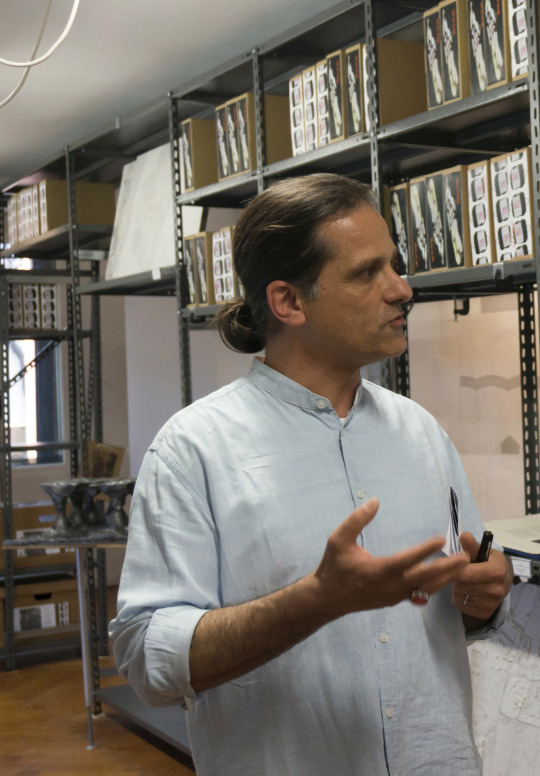
Socrates Stratis PhD. is Associate Professor and Chair of the Department of Architecture, University of Cyprus. His research focuses on the political role of architecture and urban design in supporting the commons in uncertain, contested urban environments. He is one of the main founders of the agency AA&U, director of the Laboratory of Urbanism (LUCY) and part of the Imaginary Famagusta (I.F.) team. He is the editor of the Guide to Common Urban Imaginaries in Contested Spaces. He curated the Cyprus pavilion at the 15th Venice Biennale of Architecture entitled Contested Fronts: Commoning Practices for Conflict Transformation. He is member of the scientific committee of Europan Europe. Among his implemented urban design projects is the winning project of Europan 4 for the redevelopment of the public spaces and services of the Heraklion old city waterfront in Greece.
1 note
·
View note
Video
youtube
Learn how to pronounce Mesarch in English --- MESARCH Pronunciation of Mesarch: /'mezɑːrk/ adjective Definition of Mesarch: having metaxylem developed both internal and external to the protoxylem ★ http://Learn2Pronounce.com ★ How to pronounce Mesarch | English pronunciation: https://youtu.be/oxmqLtoK_eg
#how to pronounce How to pronounce Mesarch | English pronunciation#pronunciation of How to pronounce
0 notes
Text
Now, Crown Heights Gets a Taste of Luxury
It happened in Williamsburg, and in Downtown Brooklyn. Now add Crown Heights to the Brooklyn neighborhoods seeing a wave of luxury development.
In recent years, many of the new multifamily buildings that have joined the century-old rowhouses in this central Brooklyn neighborhood have been rentals — including 409 Eastern Parkway (12 stories, 186 units), the Dean (eight stories, 120 units) on Dean Street and the side-by-side Frederick and Olmstead buildings (eight stories, 200 units) on Saint John’s Place. A few more large-scale rentals that will mix market-rate and affordable apartments are in the development pipeline.
Midsize condo buildings have also cropped up, such as the seven-story 23-unit 762 Park Place by Barrett Design.
Now a large-scale, full-service condo has arrived on the western edge of the neighborhood, on Montgomery Street. The building, to be known as 111 Montgomery, is 12 stories high and will contain 163 units, most of which will have one or two bedrooms. The building was topped out over the winter and a sales gallery is now open on Franklin Avenue.
The developers, CIM Group and LIVWRK, working with the architecture firms Fischer+Makooi and Mesarch Studio, chose brick for the facade in keeping with the exterior material often used in the neighborhood. Here, however, the brick will be an elongated gray version — “to fit in the fabric of the neighborhood but nod to something more elevated,” said Asher Abehsera, the founder and chief executive of LIVWRK. Tall windows will be framed with matte black metal.
Prices start at $499,000 for studios, $595,000 for one-bedrooms and $899,000 for two bedrooms. The building’s two three-bedroom units are expected to start at $1.72 million, said Christine Blackburn, the sales director with Compass Development, who would not provide sales figures.
A one-year membership to the Brooklyn Botanic Garden is included in the deal.
Although 111 Montgomery is one building in from Washington Avenue, which borders Prospect Park, the new project plays up its proximity to Brooklyn’s marquee green space.
Mesarch, which designed the interiors, is using natural materials in the building. The lobby, for example, will feature a moss wall and walnut strips as decorative accents. The children’s playroom will have a woodland theme.
Apartments on the top four floors offer verdant park views. On a recent tour of terraced units on the ninth floor, the faceted glass roof of the greenhouse at the botanic garden could be seen poking up through the greenery.
In contrast to those expansive views, the apartments are quite compact.
The 80 one-bedroom units range from 449 to 803 square feet, while the 60 two-bedrooms are 680 to 1,111 square feet.
But more than 70 percent of units have some outdoor space, whether terraces or Juliet balconies.
And at least your bikes won’t crowd the premises. Bike storage is located in the cellar and on floors two through eight, said the architect Fariba Makooi, the owner and principal of Fischer+Makooi, which was founded by the prolific architect Karl Fischer, who died in March. The spaces vary in size, but in total the building can accommodate 83 bikes. There is a $10 a month fee for the bike storage.
For weekly email updates on residential real estate news, sign up here. Follow us on Twitter: @nytrealestate.
Sahred From Source link Real Estate
from WordPress http://bit.ly/31BBc5t
via IFTTT
0 notes
Photo

2018 Workshop on Leisurescapes
Landscapes of Leisure: Architectural Histories of Tourism and Development
The Mesarch Lab of the Department of Architecture of the University of Cyprus organized the workshop “Landscapes of Leisure: Architectural Histories of Tourism and Development, on June 5, 2018 at the «Peace Room», 62 Ledras street, Nicosia.
Tourism has been intricately tied to international development agendas since the Cold War, and just like the themes of housing, environment, and peace, tourism has been at the root of decolonization, modernization and development strategies crossing the industrial and non-industrial worlds. This workshop aimed to offer timely and crucial insights into the potentials and perils of tourism politics, by revisiting their histories and their impact on the built environment from the 1950s until today. The workshop situated the architectural and urban history of tourist landscapes within the discourses of modernity, nation-building, urbanization, and decolonization; focusing on the way these landscapes have been intertwined with social, political, ethnic, and environmental challenges. By reflecting on the intertwinement of tourist landscapes with multiple types of politics the workshop ultimately aspired to introduce critical perspectives to the past and present discourses of development. The following speakers discussed the above-mentioned topics through case studies of landscapes of leisure in Cyprus and internationally.
Speakers
Sibel Bozdoǧan, Boston University | Jiat-Hwee Chang, National University of Singapore | Meltem Gürel, Bilkent University | Juliana Maxim, University of San Diego | Panayiota Pyla, University of Cyprus | Socrates Stratis, University of Cyprus | Maria Hadjimichael, University of Cyprus | Petros Phokaides, National Technical University of Athens | Georgia Daskalaki, University of Cyprus | Dimitris Venizelos, University of Cyprus.
Image caption:
Amathus Hotel, The Architects Collaborative International Inc. (TAC), in collaboration with Fotis Kolakidis, Limassol, 1971-1973.
Source: Κολακίδης και Συνεργάτες, ψηφιοποίηση από Mesarch Lab, UCy, 2012.
0 notes
Photo

More Than A Hotel
The Ledra Palace Through Stories of Tourism and Modernism
Panayiota Pyla and Savia Palate have given a lecture for the purposes of the exhibition Ledra Palace: Dancing on the Line at the Leventis Municipal Museum of Nicosia (Cyprus) - 5 October 2021.
The lecture has been drawing on the essay written by Palate, Phokaides, and Pyla ‘More than a Hotel: The Ledra Palace Through Stories of Tourism and Modernism’ as one of the products of a research programme coordinated by the Mesarch Lab and supported by RIF.


0 notes
Photo

Architectural Archive
Public Talk and Discussion as part of the retrospective exhibition Past-forward: Stavros Economou Unarchived
State Gallery of Contemporary Art, SPEL - 17 September 2021 (Curators: Popi Iacovou, George Artopoulos, Michalis Sioulas, Marina Christodoulidou)
Two members of the Mesarch Lab, Panayiota Pyla and Petros Phokaides, each presented a public talk and participated in the discussion on the “Architectural Archive” that explored the way architecture and its histories are written, visualized, and curated.
Coordinator:
Popi Iacovou (Lecturer, Dept. of Architecture, University of Cyprus)
Speakers:
‘Histories of the Present: Critical Repositioning on Modernism’ by Panayiota Pyla (Associate Professor, University of Cyprus)
‘Archiving Cyprus Modernism’ by Petros Phokaides, (Assistant Professor, University of Thessaly)
‘Practices Display: Between Surrogates and Images’ by Léa-Catherine Szacka (Assistant Professor, University of Manchester, 2021-2022 Academic Guest, ETH-Zurich)


0 notes
Photo

CFP on Leisurescapes
Leisurescapes: Architectures and Landscapes of Tourism in the Global Sun Belt 1945-1980
In conjunction with an ongoing Cyprus-based research project, we are pleased to invite scholars and researchers in architecture, histories of architecture, urbanism and landscape and social, cultural and environmental studies, to contribute to the collaborative Leisurescapes Project. The project took off in 2018 with an international workshop in Nicosia and a second workshop, which intends to bring potential contributors together, is planned for Spring/Summer 2021. The projected final product is an edited scholarly volume that will feature architectural, urban and landscape histories of tourism and leisure analyzed in the broader context of Cold War geopolitics, de-colonization, theories of modernization and development and the reconfiguration of economic geographies in the postwar world.
The project aims to research, document and theorize how leisure tourism became the centerpiece of postwar economies and national development programs of many countries, cutting across the ideological divides of the bi-polar Cold War world and appealing to the newly independent nations of de-colonized regions many of which joined the Non-Aligned Movement. From the proliferation of Hilton Hotels as built symbols of American “soft politics” abroad to the seaside resorts of Soviet-bloc countries conceived as incubators of a new socialist society, or to the making of Southeast Asia into a tourist paradise by economically emergent local elites, the topic evokes a rich array of physical spaces, coastal landscapes and tourism development programs reflecting the complex web of political, social, economic, environmental, cultural and aesthetic agendas that have informed their making.
We are interested in critical studies of how leisure, relaxation and vacationing were conceptualized as sites of modernization and development, how architecture, infrastructure and landscape were deployed as aesthetic expressions of these and how a supra-ideological and a-political discourse of leisure often effectively masked underlying histories of conflict, inequalities and violence. We are particularly interested in contributions that investigate the design and construction of hotels and the transformation of coastal landscapes from a wide range of theoretical positions that are not merely descriptive. We are looking for histories that engage with new theories and critical debates to unpack how specific national development agendas, discourses of design professions and multiple trans-national encounters have shaped the landscapes, physical spaces and spatial politics of tourism, ultimately, shaping multiple understandings and situated experiences of leisure.
In accordance with this goal of collective knowledge production, we are currently working on the format of the projected 2021 workshop in Cyprus, as well as developing digital means of information sharing, archiving research and compiling a bibliography. At the Mesarch Lab of UCY, we are putting together an “Informal Archive” of images, videos, case studies, news items and relevant published essays that can form a basis for discussion among contributing authors. It is our expectation that this CFP will solicit other potential participants in this project-focused agenda with a given timetable and a specific deliverable in the form of a publication.
Download the Call for Papers
Title and Abstracts of proposed papers should be up to 500 words and should be emailed to [email protected] and [email protected]. These should be accompanied by a 2-page CV and selected bibliography.
Project Coordinators/Editors
Panayiota Pyla, University of Cyprus
Sibel Bozdogan, Boston University
Petros Phokaides, National Technical University of Athens
Partial List of Contributing Authors
Melita Čavlović, University of Zagreb
Jiat-Hwee Chang, National University of Singapore
Meltem Ö. Gürel, Yaşar University
Juliana Maxim, University of San Diego
Alona Nitzan-Shiftan, Technion
Anoma Pieris, University of Melbourne
Lukasz Stanek, The University of Manchester
Timetable
Announcement of the CFP
20 December 2019
Abstract submissions due
1 March 2020
Announcement of selected proposals
24 April 2020
Skype Workshops
May/June 2020
First Drafts due
October 2020
Skype Workshops
Fall 2020
Second Drafts due (just before workshop)
April 2021
Workshop in Cyprus
May/June 2021
Final Drafts
August 2021
0 notes
Photo

2018 Workshop on Leisurescapes: Multimedia exhibition
The Constructed and the Unspoiled
Accounts of tourist development in Cyprus, 1960-1974
Multimedia exhibit in the context of the workshop “Landscapes of Leisure: Architectural Histories of Tourism and Development”
June 5th 2018 at the Peace Room (62 Ledras street – Nicosia)
In 1962, Cyprus has its picture taken. Urbanist Eugene Beaudouin, architect and urbanist Manuel Baud-Bovy and architect Aristea Rita Tzanos comprise the group of French consultants that extensively photograph the Cypriot landscape. The team was invited by the nascent Republic of Cyprus to produce a report on the island’s future in the emerging industry of tourism. Their photographic lens highlights the island’s “unspoiled”coastal landscape as the quintessential tourist asset.
The pursue of the “unspoiled” as a characteristic of the Mediterranean landscape internalizes a contradiction: If on the one hand an idealized “unspoiled” Mediterranean coastline entailed emancipatory aspirations for the North European urbanite, as it was associated with the qualities of a “pre-urban” and “non-urban” lifestyle; on the other hand, the processes of urbanization unleashed by the pursuit of the “unspoiled” as an asset for the emerging tourist industry, paradoxically eradicated these qualities from the produced landscapes, the latters being shaped instead by processes of relentless real estate speculation.
Famagusta’s leisurescape exemplifies this contradiction. Featuring as one of Cyprus’s unspoiled beaches in the French photographic collection, Famagusta’s Golden Coast becomes, less than a decade later, the country’s flagship leisurescape, catering to half of the island’s mass-tourism flows.Far from the 1962 Edenic visions captured by the photographic lens of the French team, the pictures of the 1970s Famagusta depict a coastal landscape densely constructed with hotels that offered all the amenities of modern urban life for the European and North American tourist. The remarkable transformations of the Golden Coast during the period of 1960 - 1974 make visible this often-concealed aspect of landscapes of leisure as operational landscapes of a post-Fordist economy. Moreover, and as they increasingly became part of the government’s agendas for economic development during the 1960s and early 70s, these developmental landscapes also embody various forms of politics, inequality and dispossession. Or even, they become spaces of contestation and conflict, despite the iconography of relaxation portrayed in promotion pamphlets and newspaper articles in Cyprus and internationally.
The multimedia exhibit titled “The Constructed and the Unspoiled” curated by the Mesarch Lab team is a reflection on these thoguhts. The exhibit attempted a synthesis of photographic content from the two archives mentioned above (the Beaudouin - Baud-Bovy – Tzanos photographic collection hosted at the Bank of Cyprus Cultural Foundation and the Press Information Office of the Republic of Cyprus photo archives of the period 1960-1974) in conversation with other archival material (architectural models and publications). The parallel display of what was envisioned (extrapolating from the perspectives introduced by the French photo archive) and what was constructed until the early 70s (documented in the various photographic collections of the Press Information Office) aimed to highlight precisely this contradictory nature of the landscapes of leisure: as both developmental landscapes and as spaces permeated by utopian aspirations.
The Mesarch Lab is grateful to the Press Information Office of the Republic of Cyprus and the Bank of Cyprus Cultural Foundation, for offering access to their archival material. Special thanks to Dr Ioanna Hadjicosti, Director of the Bank of Cyprus Cultural Foundation and Dr Christodoulos Hadjichristodoulou, Director of the Bank of Cyprus Historical Archive, for their engagement and interest in our research work.
Archival Research: Dimitris Venizelos
Curators: Dimitris Venizelos, Panayiota Pyla, Petros Phokaides.
Assistant curator: Michalis Psaras

References
Gaviria, Mario. “La producción neocolonialista del espacio.” Papers. Revista de Sociologia3, (July 1, 1974): 201–17.
Lefebvre, Henri. The Production of Space. Oxford, OX, UK ; Cambridge, Mass., USA: Blackwell, 1991: chapters 4-6
Lefebvre, Henri. Toward an Architecture of Enjoyment. Minneapolis: University of Minnesota Press, 2014.
Lefebvre, Henri. Introduction to Libro negro sobre la autopista de la Costa Blanca, ed. Mario Gaviria (Valencia: Editorial Cosmos, 1973), xiii–xiv.
Ministry of Commerce and Industry, Republic of Cyprus, Ministry of Foreign Affairs, French Republic—Eugene Beaudouin, Manuel Baud- Bovy, Aristea Rita Tzanos. Cyprus Study of Tourist Development. 1962.
Raymond, Henri. “Le littoral et l’usager.” L’Architecture d’Aujourd’Hui, no. 175 (1974): 28.
Raymond, Henri. Les significations culturelles du littoral français. Institut d’Etudes et de Recherches en Architecture et Urbanisme, 1973.
Raymond, Henri. “Le littoral et l’usager.” L’Architecture d’Aujourd’Hui, no. 175 (1974): 28.
LEGEND
1. L’Architecture d’Aujourd’Hui, no. 175 (1974): 28
2. Review of foreign and national newspapers on Hotel developments in Cyprus (Mesarch Lab working documents)
3. Original Model of Golden Sands Hotel by Garnett-Cloughley-Blakemore Architects. Donated to Mesarch Lab by Derry Garnett
4. “Microcosms”, Mesarch Lab working documents
5. The Golden Sands hotel Promotional video from Golden Sands hotel opening on 7 July 1973, Patrick Garnett’s archive, Mpeg video, 17:26
6. Photographs of Famagusta’s leisure strip – content from various photographic collections of the Press Information Office of the Republic of Cyprus
7. Photographs of the Beaudouin-Bovy-Tzanos archive, hosted at the Bank of Cyprus Cultural Foundation.
8. Workshop presentations
0 notes
Text
Landscapes of Leisure and Politics: The Architectural History of Tourism and Conflict in Cyprus (Research program, 2019-2021)
This research project offers a rigorous historical and critical analysis of the architecture of tourism in Cyprus, in order to reflect on the intertwinement of tourist landscapes with multiple types of politics—specifically, social, ethnic, and environmental conflicts.
Key objectives:
- Shape contributions to the architectural history of modernism.
- Cast critical perspectives on the practice of architectural design and planning in contested areas.
- Provide new knowledge on the urban, environmental and heritage dimensions of tourism infrastructures/building.
Grant: Research Promotion Foundation, Excellence Hub, 2019-2021
Partners: University of Cyprus (Host), Technion (Israel), Boston University (USA)
Research team: Panayiota Pyla (Coordinator), Alona Nitzan-Shiftan, Sibel Bozdoǧan, Petros Phokaides, Demetris Venizelos
Follow updates on the Leisurescapes research project here
Go here for more on research projects of Mesarch Lab.
0 notes
Text
Landscapes of Tourism in Cyprus and Bali: Architectural, Social and Environmental Dimensions (Research project, 2019-2020)
This research project develops a comparative critical history of the impact of tourism on the architecture and landscapes in Cyprus and the Eastern Mediterranean and the Island Southeast Asia, specifically Bali, Indonesia.
Objectives:
- To produce new historical knowledge on the connections of modern architecture and tourism in Cyprus and Bali, Indonesia that can inform the history and theory of modern architecture.
- Shape critical perspectives on the architectural history of tourism in Cyprus and Bali that can inform the domains of architectural design/planning.
- Exposing the complexities and contradictions of social/environmental agendas advanced by hotels, resorts and other tourist interventions, to ultimately provide a broader basis for assessing current sustainable development strategies.
Grant: Research Promotion Foundation, International collaborations - Dual targeting, 2019-2021
Partners: University of Cyprus (Host) and National University of Singapore.
Research team: Panayiota Pyla (Coordinator), Jiat-Hwee Chang
Go here for more on research projects of Mesarch Lab.
0 notes
Photo

Multimedia exhibition
The Constructed and the Unspoiled
Accounts of tourist development in Cyprus, 1960-1974
Multimedia exhibit in the context of the workshop “Landscapes of Leisure: Architectural Histories of Tourism and Development”
June 5th 2018 at the Peace Room (62 Ledras street – Nicosia)
In 1962, Cyprus has its picture taken. Urbanist Eugene Beaudouin, architect and urbanist Manuel Baud-Bovy and architect Aristea Rita Tzanos comprise the group of French consultants that extensively photograph the Cypriot landscape. The team was invited by the nascent Republic of Cyprus to produce a report on the island’s future in the emerging industry of tourism. Their photographic lens highlights the island’s “unspoiled”coastal landscape as the quintessential tourist asset.
The pursue of the “unspoiled” as a characteristic of the Mediterranean landscape internalizes a contradiction: If on the one hand an idealized “unspoiled” Mediterranean coastline entailed emancipatory aspirations for the North European urbanite, as it was associated with the qualities of a “pre-urban” and “non-urban” lifestyle; on the other hand, the processes of urbanization unleashed by the pursuit of the “unspoiled” as an asset for the emerging tourist industry, paradoxically eradicated these qualities from the produced landscapes, the latters being shaped instead by processes of relentless real estate speculation.
Famagusta’s leisurescape exemplifies this contradiction. Featuring as one of Cyprus’s unspoiled beaches in the French photographic collection, Famagusta’s Golden Coast becomes, less than a decade later, the country’s flagship leisurescape, catering to half of the island’s mass-tourism flows.Far from the 1962 Edenic visions captured by the photographic lens of the French team, the pictures of the 1970s Famagusta depict a coastal landscape densely constructed with hotels that offered all the amenities of modern urban life for the European and North American tourist. The remarkable transformations of the Golden Coast during the period of 1960 - 1974 make visible this often-concealed aspect of landscapes of leisure as operational landscapes of a post-Fordist economy. Moreover, and as they increasingly became part of the government’s agendas for economic development during the 1960s and early 70s, these developmental landscapes also embody various forms of politics, inequality and dispossession. Or even, they become spaces of contestation and conflict, despite the iconography of relaxation portrayed in promotion pamphlets and newspaper articles in Cyprus and internationally.
The multimedia exhibit titled “The Constructed and the Unspoiled” curated by the Mesarch Lab team is a reflection on these thoguhts. The exhibit attempted a synthesis of photographic content from the two archives mentioned above (the Beaudouin - Baud-Bovy – Tzanos photographic collection hosted at the Bank of Cyprus Cultural Foundation and the Press Information Office of the Republic of Cyprus photo archives of the period 1960-1974) in conversation with other archival material (architectural models and publications). The parallel display of what was envisioned (extrapolating from the perspectives introduced by the French photo archive) and what was constructed until the early 70s (documented in the various photographic collections of the Press Information Office) aimed to highlight precisely this contradictory nature of the landscapes of leisure: as both developmental landscapes and as spaces permeated by utopian aspirations.
The Mesarch Lab is grateful to the Press Information Office of the Republic of Cyprus and the Bank of Cyprus Cultural Foundation, for offering access to their archival material. Special thanks to Dr Ioanna Hadjicosti, Director of the Bank of Cyprus Cultural Foundation and Dr Christodoulos Hadjichristodoulou, Director of the Bank of Cyprus Historical Archive, for their engagement and interest in our research work.
Archival Research: Dimitris Venizelos
Curators: Dimitris Venizelos, Panayiota Pyla, Petros Phokaides.
Assistant curator: Michalis Psaras
References
Gaviria, Mario. “La producción neocolonialista del espacio.” Papers. Revista de Sociologia3, (July 1, 1974): 201–17.
Lefebvre, Henri. The Production of Space. Oxford, OX, UK ; Cambridge, Mass., USA: Blackwell, 1991: chapters 4-6
Lefebvre, Henri. Toward an Architecture of Enjoyment. Minneapolis: University of Minnesota Press, 2014.
Lefebvre, Henri. Introduction to Libro negro sobre la autopista de la Costa Blanca, ed. Mario Gaviria (Valencia: Editorial Cosmos, 1973), xiii–xiv.
Ministry of Commerce and Industry, Republic of Cyprus, Ministry of Foreign Affairs, French Republic—Eugene Beaudouin, Manuel Baud- Bovy, Aristea Rita Tzanos. Cyprus Study of Tourist Development. 1962.
Raymond, Henri. “Le littoral et l’usager.” L’Architecture d’Aujourd’Hui, no. 175 (1974): 28.
Raymond, Henri. Les significations culturelles du littoral français. Institut d’Etudes et de Recherches en Architecture et Urbanisme, 1973.
Raymond, Henri. “Le littoral et l’usager.” L’Architecture d’Aujourd’Hui, no. 175 (1974): 28.
LEGEND
1. L’Architecture d’Aujourd’Hui, no. 175 (1974): 28
2. Review of foreign and national newspapers on Hotel developments in Cyprus (Mesarch Lab working documents)
3. Original Model of Golden Sands Hotel by Garnett-Cloughley-Blakemore Architects. Donated to Mesarch Lab by Derry Garnett
4. “Microcosms”, Mesarch Lab working documents
5. The Golden Sands hotel Promotional video from Golden Sands hotel opening on 7 July 1973, Patrick Garnett’s archive, Mpeg video, 17:26
6. Photographs of Famagusta’s leisure strip – content from various photographic collections of the Press Information Office of the Republic of Cyprus
7. Photographs of the Beaudouin-Bovy-Tzanos archive, hosted at the Bank of Cyprus Cultural Foundation.
8. Workshop presentations
0 notes
Photo

Workshop on Leisurescapes
Landscapes of Leisure:
Architectural Histories of Tourism and Development
The Mesarch Lab of the Department of Architecture of the University of Cyprus organizes the workshop “Landscapes of Leisure: Architectural Histories of Tourism and Development, on June 5, 2018. Presentations and discussions will take place at the «Peace Room» (62 Ledras street – Nicosia) from 12:30pm to18:45pm according to the program below and are open to the public.
Tourism has been intricately tied to international development agendas since the Cold War, and just like the themes of housing, environment, and peace, tourism has been at the root of decolonization, modernization and development strategies crossing the industrial and non-industrial worlds. This workshop aims to offer timely and crucial insights into the potentials and perils of tourism politics, by revisiting their histories and their impact on the built environment from the 1950s until today. The workshop aims to situate the architectural and urban history of tourist landscapes within the discourses of modernity, nation building, urbanization and decolonization; focusing on the way these landscapes have been intertwined with social, political, ethnic, and environmental challenges. By reflecting on the intertwinement of tourist landscapes with multiple types of politics the workshop ultimately aspires to introduce critical perspectives to the past and present discourses of development. The presentations will discuss the above-mentioned topics through case studies of landscapes of leisure in Cyprus and internationally.
Speakers
Sibel Bozdoǧan, Boston University | Jiat-Hwee Chang, National University of Singapore | Meltem Gürel, Bilkent University | Juliana Maxim, University of San Diego | Panayiota Pyla, University of Cyprus | Socrates Stratis, University of Cyprus | Maria Hadjimichael, University of Cyprus | Petros Phokaides, National Technical University of Athens | Georgia Daskalaki, University of Cyprus | Dimitris Venizelos, University of Cyprus.
Tuesday – June 5, 2018
09:00 - 11:00
Walk/visit Nicosia city center, Saray and Ledra Palace hotel
12:30 - 12:50 Introduction to the workshop + exhibition
Panayiota Pyla and Petros Phokaides, Is tourism a passport to development and peace? think twice
12:50 - 14:30 Session 1: Landscapes of tourism
Moderator: Petros Phokaides
Juliana Maxim, Romanian Black Sea resorts in the 1950s and 1960s
Georgia Daskalaki, ‘Aphrodite’s realm’: representations of tourist landscapes as symbols of modernization
Dimitris Venizelos, Modernizing the Golden Coast: the United Nations agenda in Cyprus
Meltem Gürel, Modernizing Florya Coast as a leisure and tourism landscape in the 1950s
14:45 - 16:05 Session 2: Cyprus leisure-scapes: Contested pasts/futures
Moderator: Socrates Stratis
Dimitris Venizelos, The constructed and the unspoiled: tourist development in Cyprus through photographic archives
Petros Phokaides, The historiography of leisure and conflict: the Famagusta modern coastline
Maria Hadjimichael, The stealing of the seashore as a second wave of the enclosure movement: examples from Cyprus
Socrates Stratis, Countermapping the Cypriot coastline
16:30 – 17:50 Session 3: The (geo)politics of leisure
Moderator: Panayiota Pyla
Sibel Bozdoǧan, Geopolitics, mobility and hospitality: landscapes of tourism in postwar Turkey
Panayiota Pyla, A “clean” industry for Cyprus: the politics and economics of leisure and development
Jiat-Hwee Chang, The dark recesses of the Bali style: architecture, cultural tourism and violent conflicts
18:00 – 18.45 Roundtable discussion
Image caption:
Amathus Hotel, The Architects Collaborative International Inc. (TAC), in collaboration with Fotis Kolakidis, Limassol, 1971-1973.
Source: Κολακίδης και Συνεργάτες, ψηφιοποίηση από Mesarch Lab, UCy, 2012
0 notes